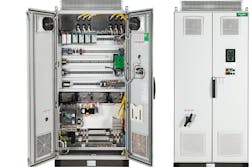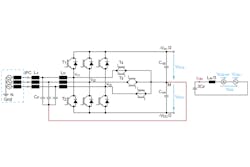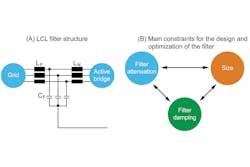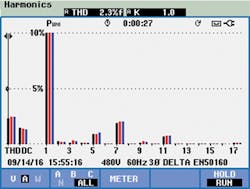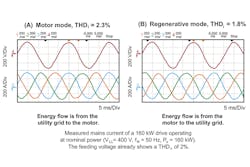New VFD technologies in harmonic mitigation
Harmonics in electrical systems has been a major concern for engineers and designers since the invention of inverter technologies. Since resources and energy are limited, system suppliers have become increasingly focused on the efficient use of variable frequency drives (VFD), including the mitigation of harmonics generated by the VFDs in their systems.
As the search for the optimal harmonic mitigation technology has introduced technologies such as multipulse rectification and passive/active filters to deal with the issue of harmonics, the three-level active front-end technology used in the Altivar 680 and Altivar 980 Low Harmonic AFE Drive Solutions from Schneider Electric offers harmonic mitigation performance in a small footprint, allowing for more flexibility in numerous applications. It is an honor to share more about this technology as a 2017 Processing Breakthrough Product of the Year.
The issue of harmonics
To understand harmonics, the types of loads in variable frequency applications — linear and non-linear — must be understood first. A linear load is where the current waveform has the same shape as the supply voltage. A non-linear load is where the current waveform changes with the supply voltage.
Non-linear loads are common in all industries and are often caused by equipment such as welding machines, induction furnaces, power supplies and, of course, VFDs. VFDs have input rectifiers, which produce an input current that is non-sinusoidal. These currents can be represented by a sinusoidal fundamental current and additional sinusoidal harmonic currents. A high level of harmonics can affect the efficiency and performance of other electrical devices connected to the same input power supply.
Figure 2. Three-level design with CM filter reduction.
Power distribution systems typically include various types of power components, such as reactors and transformers. As current flows through these electrical components, each component introduces a level of impedance. With the introduction of impedance in the system, a certain level of voltage drop is expected. This voltage drop is directly proportional to the total amount of current flowing through the given system.
To improve power quality in the electrical systems, many types of harmonic mitigation architectures can be deployed. These non-linear loads are the source of harmonic currents, which cause voltage distortions and power quality issues that impact each electrical component in the system, disrupting the control infrastructure supporting processes. This can result in unwanted equipment behavior and even power loss. Harmonic content in power distribution systems can lead to undesired outcomes such as disturbances in communications, increased operational expenses and loss of revenue.
In addition, some system loads drawing harmonic current often draw currents that result in increased ground currents and/or induce common mode noise. This can cause increased motor bearing temperatures in three-phase induction or permanent magnet motors. Both of these conditions can negatively impact the service life expectancy of the equipment connected to the power grid.
This article looks at how the three-level active rectification technology works to mitigate these harmonics.
Three-level active rectification technology
By replacing the typical six input diodes with insulated gate bipolar transistors (IGBTs), such as the ones used on the output of most drives, the input current wave shape can be controlled. This is where the active part comes into play.
Three-level active rectification is used to improve input current waveforms. This is achieved by the addition of three bidirectional IGBT switches connected to the DC bus. This three-level topology also uses an additional common mode (CM) filter stage. The CM filter stage allows for high efficiency and behaves like a passive rectifier circuit in terms of CM voltage.
To generate sinusoidal input currents in phase with the mains voltage, the current is shaped by the switching actions of the input IGBTs.
Low harmonic three-level active rectification incorporates a boost-type converter. Boost-type converters allow the DC bus to achieve voltages at higher levels than the mains peak voltage. The DC bus voltage is dynamic and adapted to match the mains behavior by use of a dedicated control algorithm. This design allows the switching frequency to be increased, which allows a more optimized, space-saving, active input stage.
Three-level active front-end drive solutions incorporate an input LCL filter design. This efficient, low-pass input filter allows low-frequency voltage emissions to pass while attenuating (rejecting) high-frequency emissions. See graphic below.
Figure 5. Optimized input LCL filter
The performance of three-level drive systems is dependent on this reduction of total voltage emission at the input terminals. At various multiples of the switching frequency, voltage emissions are reduced to less than 0.5 percent, substantially less than previous-generation, two-level technologies.
These low harmonic drive solutions actively dampen the LCL filter by deploying a lossless control strategy. The control strategy is implemented in the controller software and does not require additional passive components. The LC tank is directly damped by the converter stage itself. Thus, no additional losses occur due to passive damping elements, and the efficiency of the low harmonic drive system is increased.
Why choose three-level active front-end technology?
This technology makes it possible to replace a passive diode bridge rectifier with a low-harmonic input stage or a regenerative input stage. Three-level active front-end drive solutions — with or without regenerative capabilities — are flexible for any industry and any application that requires a compact low-harmonic solution. The three-level active front-end drive solutions bring a total current harmonic distortion (THDi) to 2.3 percent.
Figure 3. Input current of ATV680/980 low harmonic drives. Note the sinusoidal wave shape and balanced currents.
Figure 4. Input current of ATV680/980 low harmonic drives. THDv is 2.3 percent of the fundamental (60Hz) component.
Benefits include no additional high-frequency common mode voltage, lower cost of total ownership and dramatically reduced harmonics. One of the most beneficial elements these low harmonic drives deliver is lower bearing currents when compared to simple two-level active front-end drives. This three-level active rectification design results in lower output bearing currents, similar to those found with typical six-pulse drive systems. These reduced bearing currents increase the service life of the motor bearings.
Due to the optimized LCL input filter, high-frequency emissions caused by the switching actions of the active bridge are well attenuated to values below 0.5 percent. The possible resonance of the input filter is damped by a lossless active damping control strategy implemented in the controller of the low harmonic drive system. The resonant tank built by the filter elements cannot be excited by the utility grid. This optimized input filter allows the three-level active front-end drives to have a 40 to 50 percent reduced footprint when compared to 18-pulse solutions.
Measured main current of a 160 kW drive operating at nominal power (V = 400 V, f = 50 Hz, P = 160 kW). The feeding voltage already shows a THD of 2 percent.
The introduction of this new solution for addressing the challenge of harmonics opens a new chapter in power conversion devices. Due to the three-level topology, the lossless damping of the input filter and the optimized DC bus voltage, this low harmonic solution exhibits high efficiency and improves both reliability in generator applications by maintaining a lower power factor near unity of VFD-rated full-load amps. This high efficiency, combined with the high input current quality, small size and significant reduction of high-frequency CM voltage caused by the active bridge, make three-level active front-end solutions a smart technology selection for a drive system with low harmonic requirements, with or without regenerative capabilities.
Garrett Abbott-Frey is the U.S. Enclosed Drive Solutions Offer Manager in the Industry Business of Schneider Electric. Based in Raleigh, North Carolina, Abbott-Frey brings nearly five years of professional experience to the role, drawing from previous positions in OEM Machine Design and Electric Motor and Drives validation and testing. He currently focuses on enclosed drive systems targeting the upstream oil and gas industry to support production process optimization for customer artificial lift applications. Abbott-Frey has led numerous training sessions on harmonics, drives commissioning and other drives-related topics. He recently published the whitepaper, "Transformation from Six-Pulse to Low Harmonic, Three-Level, Active Rectification Technologies." Abbott-Frey has a bachelor’s degree in mechanical engineering from North Carolina State University with a focus on physics and environmental science.
